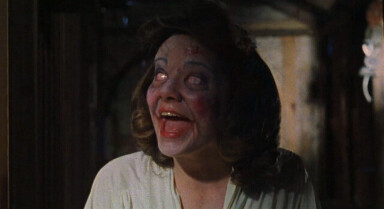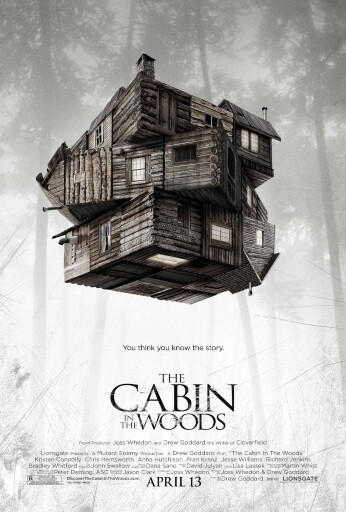Cabin horror, sometimes referred to as “cabin in the woods” horror, is a subgenre of horror movies and books that typically takes place in a remote cabin or similarly isolated location of some kind. These movies often feature a group of young adults who are stalked and terrorized by some sort of supernatural or human threat. Some common themes in cabin horror stories include the fear of the unknown, the danger of isolation, and the consequences of reckless behavior. Overall, cabin horror movies often use their isolated and claustrophobic settings to create a sense of tension and unease, while also playing on the audience’s fears of being trapped and hunted by an unseen threat.
Some common tropes of the cabin horror genre include:
- The remote location: The cabin is often located far from civilization, making it difficult for the characters to get help or escape from their attackers.
- The group of friends: The main characters are often a group of young adults who are on vacation together, allowing for the opportunity to explore themes of friendship and group dynamics.
- The supernatural threat: The cabin horror genre often features supernatural elements, such as ghosts, demons, or other monsters.
- The slasher element: Cabin horror movies may also include a human threat, such as a deranged killer who is stalking the characters and picking them off one by one.
- The final girl: A common trope of horror movies in general, the “final girl” is typically a female character who survives the attack and is left to face the aftermath of the horror.

Cabin horror has been popular since at least the 1980s, when movies like Friday the 13th and The Evil Dead helped popularize the subgenre. However, the genre has continued to evolve over the years, with movies like The Cabin in the Woods and Knock at the Cabin Door playing with audience expectations and subverting some of the traditional tropes of the genre.
Below are examples of popular films, books, and graphic novels in the cabin horror genre.
Cabin Horror Movies
The Evil Dead (1981) – A group of friends travel to a remote cabin in the woods for a weekend getaway, but stumble upon an ancient tome that unleashes a demonic force that possesses them one by one. This movie is a classic example of cabin horror, featuring a remote location, supernatural threat, and group of friends being stalked by an unseen enemy.
Friday the 13th (1980) – A group of counselors arrive at Camp Crystal Lake to prepare it for the summer season, but are stalked and killed by an unseen assailant. This movie helped popularize the slasher subgenre of horror and features a remote location, group of young adults, and a killer on the loose.
The Cabin in the Woods (2012) – A group of friends travel to a remote cabin for a weekend getaway, only to discover that they are being monitored and manipulated by a mysterious organization. This movie plays with the audience’s expectations of the cabin horror genre and features elements of both supernatural and science fiction horror.

Tucker and Dale vs. Evil (2010) – Two hillbillies, Tucker and Dale, buy a remote cabin in the woods for a vacation home, but their attempts to enjoy a peaceful weekend are interrupted by a group of college students who mistake them for deranged killers. This movie is a comedic take on the cabin horror genre, featuring elements of both horror and satire.
The Cabin (2018) – When a group of friends go on a weekend trip to a remote cabin in the woods, they unwittingly stumble upon an ancient curse that begins to take over their minds and bodies. This curse brings the cabin and the surrounding woods to life, creating a hostile environment where the friends are constantly under attack. The supernatural elements of the film add a layer of mystery and terror to the already tense situation, creating a unique and engaging horror experience.
The Lodge (2019) – Two children and their stepmother are snowed in at a remote cabin during the holidays, but as various conflicts begin to escalate, it becomes clear that something sinister is at play. The movie explores the deteriorating mental states of the characters as they become trapped in the cabin, which creates an atmosphere of dread and uncertainty. As tensions rise between the characters, strange occurrences begin to happen, and the line between reality and nightmare becomes blurred.
Cabin Horror Books & Comics
The Troop by Nick Cutter (2014) – A group of boy scouts and their troop leader venture to a remote island off the coast of Prince Edward Island for a weekend camping trip, but are soon stalked by a horrifying creature that feeds on flesh. The book also features elements of body horror, as the infection caused by the creature causes gruesome physical transformations and mutations in the characters. The combination of the group’s struggle for survival and the disturbing physical changes they experience creates a chilling and unsettling atmosphere.
Wytches by Scott Snyder and Jock (2014) – A family moves to a small town in New Hampshire to escape their troubled past, but are targeted by a coven of witches who dwell in the nearby woods. This graphic novel adds terrifying narrative turns with the inclusion of the witch’s dark magic and the mystery surrounding the town’s past, creating a gripping and chilling read. Overall, Wytches fits within the cabin horror genre due to its remote setting, supernatural elements, and atmosphere of terror and suspense.
The Cabin at the End of the World by Paul Tremblay (2018) – A family vacations at a remote cabin in the woods, but are soon visited by a group of strangers who claim that the end of the world is imminent and that they need the family’s help to prevent it. The book creates a sense of claustrophobia and isolation within the cabin, as the family members are cut off from the rest of the world and forced to confront the strangers who have invaded their sanctuary. The story also does a great job of blending elements of psychological horror with supernatural and apocalyptic themes, creating a sense of unease and tension that builds throughout the book.
Camp Slaughter by Sergio Gomez (2019) – The story follows a group of teenagers who are sent to a summer camp in the woods, but soon discover that the camp has a dark and deadly history. The camp was the site of a mass murder years before, and the spirits of the victims have returned to seek revenge on those who dare to set foot on the grounds. The isolation of the camp and the surrounding woods creates a sense of claustrophobia and paranoia among the characters, as they realize that they are cut off from the rest of the world and facing unknown dangers lurking in the shadows.
The Shuddering by Ania Ahlborn (2019) – A group of friends embark on a winter vacation in a remote cabin in the mountains, only to discover that the cabin and the surrounding woods hold a dark and terrifying secret. The book also features elements of supernatural horror, as the friends are confronted by mysterious and malevolent forces that seem to be connected to the cabin and the surrounding woods. The supernatural elements of the story add to the horror and create a sense of unease and uncertainty as the characters struggle to survive and uncover the truth about the cabin’s dark past.

Ben’s love for horror began at a young age when he devoured books like the Goosebumps series and the various scary stories of Alvin Schwartz. Growing up he spent an unholy amount of time binge watching horror films and staying up till the early hours of the morning playing games like Resident Evil and Silent Hill. Since then his love for the genre has only increased, expanding to include all manner of subgenres and mediums. He firmly believes in the power of horror to create an imaginative space for exploring our connection to each other and the universe, but he also appreciates the pure entertainment of B movies and splatterpunk fiction.
Nowadays you can find Ben hustling his skills as a freelance writer and editor. When he’s not building his portfolio or spending time with his wife and two kids, he’s immersing himself in his reading and writing. Though he loves horror in all forms, he has a particular penchant for indie authors and publishers. He is a proud supporter of the horror community and spends much of his free time reviewing and promoting the books/comics you need to be reading right now!
